Abstract
OBJECTIVE--To assess the preference of terminally ill patients with cancer for their place of final care. DESIGN--Prospective study of randomly selected patients with cancer from hospital and the community who were expected to die within a year. Patients expected to live less than two months were interviewed at two week intervals; otherwise patients were interviewed monthly. Their main carer was interviewed three months after the patient's death. SETTING--District general hospital, hospices, and patients' homes. MAIN OUTCOME MEASURE--Stated preferred place of final care; actual place of death; reason for final hospital admission for those in hospital; community care provision required for home care. RESULTS--Of 98 patients approached, 84 (86%) agreed to be interviewed, of whom 70 (83%) died during the study and 59 (84%) stated a preferred place of final care: 34 (58%) wished to die at home given existing circumstances, 12 (20%) in hospital, 12 (20%) in a hospice, and one (2%) elsewhere. Their own home was the preferred place of care for 17 (94%) of the patients who died there, whereas of the 32 patients who died in hospital 22 (69%) had stated a preference to die elsewhere. Had circumstances been more favourable 67% (41) of patients would have preferred to die at home, 16% (10) in hospital, and 15% (9) in hospice. CONCLUSION--With a limited increase in community care 50% more patients with cancer could be supported to die at home, as they and their carers would prefer.
Full text
PDF


Selected References
These references are in PubMed. This may not be the complete list of references from this article.
- Allbrook D. Dying of cancer. Home, hospice or hospital? Med J Aust. 1984 Aug 4;141(3):143–144. doi: 10.5694/j.1326-5377.1984.tb113057.x. [DOI] [PubMed] [Google Scholar]
- Bates T., Hoy A. M., Clarke D. G., Laird P. P. The St Thomas' Hospital terminal care support team. A new concept of hospice care. Lancet. 1981 May 30;1(8231):1201–1203. doi: 10.1016/s0140-6736(81)92361-8. [DOI] [PubMed] [Google Scholar]
- Doyle D. Domiciliary terminal care: demands on statutory services. J R Coll Gen Pract. 1982 May;32(238):285–291. [PMC free article] [PubMed] [Google Scholar]
- Hockley J. M., Dunlop R., Davies R. J. Survey of distressing symptoms in dying patients and their families in hospital and the response to a symptom control team. Br Med J (Clin Res Ed) 1988 Jun 18;296(6638):1715–1717. doi: 10.1136/bmj.296.6638.1715. [DOI] [PMC free article] [PubMed] [Google Scholar]
- Hoskin P. J., Hanks G. W. The management of symptoms in advanced cancer: experience in a hospital-based continuing care unit. J R Soc Med. 1988 Jun;81(6):341–344. doi: 10.1177/014107688808100615. [DOI] [PMC free article] [PubMed] [Google Scholar]
- Morris J. N., Suissa S., Sherwood S., Wright S. M., Greer D. Last days: a study of the quality of life of terminally ill cancer patients. J Chronic Dis. 1986;39(1):47–62. doi: 10.1016/0021-9681(86)90106-2. [DOI] [PubMed] [Google Scholar]
- Parkes C. M. Terminal care: home, hospital, or hospice? Lancet. 1985 Jan 19;1(8421):155–157. [PubMed] [Google Scholar]
- Rees W. D. Role of the hospice in the care of the dying. Br Med J (Clin Res Ed) 1982 Dec 18;285(6357):1766–1768. doi: 10.1136/bmj.285.6357.1766. [DOI] [PMC free article] [PubMed] [Google Scholar]
- Spitzer W. O., Dobson A. J., Hall J., Chesterman E., Levi J., Shepherd R., Battista R. N., Catchlove B. R. Measuring the quality of life of cancer patients: a concise QL-index for use by physicians. J Chronic Dis. 1981;34(12):585–597. doi: 10.1016/0021-9681(81)90058-8. [DOI] [PubMed] [Google Scholar]


